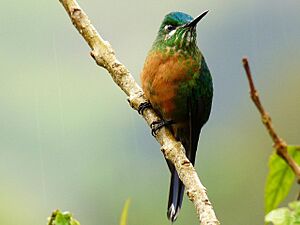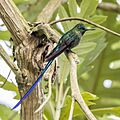Long-tailed sylph facts for kids
Quick facts for kids Long-tailed sylph |
|
|---|---|
 |
|
| Male A. k. mocoa, Ecuador | |
 |
|
| Female A. k. emmae, Colombia | |
| Conservation status | |
| Scientific classification | |
| Genus: |
Aglaiocercus
|
| Species: |
kingii
|
 |
|
The long-tailed sylph (Aglaiocercus kingii) is a stunning type of hummingbird. These tiny, colorful birds are known for their incredibly fast wingbeats and their love for flower nectar. You can find the long-tailed sylph living in the beautiful mountains of Bolivia, Colombia, Ecuador, Peru, and Venezuela.
Contents
Meet the Long-Tailed Sylph: A Tiny Hummingbird
Hummingbirds are amazing birds, and the long-tailed sylph is no exception! They belong to a group of hummingbirds called "coquettes." Even though its name suggests a super long tail, its tail isn't much longer than those of its close relatives.
What Makes the Long-Tailed Sylph Special?
Scientists have studied the long-tailed sylph for a long time. It belongs to a group of birds called Aglaiocercus, which also includes the violet-tailed sylph and the Venezuelan sylph. For a while, scientists wondered if these three were actually one or two species, but now they agree there are three different ones.
There are six different types, or subspecies, of the long-tailed sylph. Each one has slight differences in where they live and how they look.
- A. k. margarethae
- A. k. caudatus
- A. k. emmae
- A. k. kingii
- A. k. mocoa
- A. k. smaragdinus
Appearance: How to Spot a Long-Tailed Sylph
Long-tailed sylphs are small birds with a lot of sparkle! They have a short, black beak.
Male vs. Female Long-Tailed Sylphs
Male long-tailed sylphs are usually about 16 to 19 centimeters (6 to 7.5 inches) long. This measurement includes their very long outer tail feathers, which can be about 12 centimeters (4.7 inches) long! They weigh around 5 to 6 grams (0.18 to 0.21 ounces).
Females are a bit smaller, measuring about 9.7 to 11.7 centimeters (3.8 to 4.6 inches) long. They weigh about 4.5 to 4.7 grams (0.16 to 0.17 ounces).
Colors and Features of the Long-Tailed Sylph
The most common type, A. k. kingii, has a shining emerald green crown on its head. Their upper body is a metallic bronzy green, and their belly is a duller green. Males often have a blue or violet throat. Their long outer tail feathers are iridescent blue, green, and violet on top, and bluish-black underneath.
Female A. k. kingii birds have similar upper body colors to the males. Their tail is short and slightly forked, with dark blue outer feathers that have white tips. Their head is metallic green with a white stripe on their cheek. Their throat is white to buffy with green speckles. Their belly is a warm cinnamon color.
Subspecies Color Variations
Other subspecies have their own unique touches:
- A. k. margarethae males are a lighter green on top.
- A. k. emmae males are a paler green and have a bright green throat. Females have more green spots on their white throat.
- A. k. mocoa males have a shinier green on top and a sapphire blue to purple throat.
- A. k. smaragdinus has a shorter tail and a greenish-blue throat. Females have bronzy green upper parts and a chestnut wash on their back.
Where Long-Tailed Sylphs Live: Their Habitat
The long-tailed sylph lives in different parts of South America. Each subspecies has its own specific home range:
- A. k. margarethae lives in north-central and coastal Venezuela.
- A. k. caudatus is found in western Venezuela and the Andes mountains into northern Colombia.
- A. k. emmae lives in the northern Central and southern Western Andes of Colombia, extending into northwestern Ecuador.
- A. k. kingii makes its home in the Eastern Andes of Colombia.
- A. k. mocoa is found in the southern Central Andes of Colombia, through Ecuador, and into northern Peru.
- A. k. smaragdinus lives in the eastern Andes of Peru, reaching south into west-central Bolivia.
These hummingbirds prefer open areas like scrublands, forest edges, and clearings. You might also spot them in gardens, younger forests, and high-elevation grasslands. They live at elevations between 900 and 3000 meters (about 2,950 to 9,840 feet) above sea level.
Behavior: How Long-Tailed Sylphs Live
Long-tailed sylphs are active birds with interesting habits, from how they move to what they eat.
Movement and Migration
These birds move around quite a bit. Some populations in the Andes mountains travel between lower and higher elevations depending on the season. For example, A. k. caudatus is thought to migrate between Venezuela and Colombia. Another subspecies, A. k. emmae, seems to be present in southwestern Colombia only during the wet season.
Feeding Habits: What They Eat
The long-tailed sylph's diet includes two main things: nectar from flowers and small insects. They are very clever about how they get their food.
They often fly a "trap-line" route, visiting a circuit of flowering plants. They also sometimes defend a specific area of flowers from other birds. When feeding, they usually hover in front of flowers, but sometimes they will cling to a flower. They can even "rob" nectar by piercing the base of a flower to get the sweet liquid without pollinating it.
To catch insects, they "hawk" them, which means they fly out from a perch to snatch insects in mid-air. At lower elevations, they tend to feed in the treetops. In higher areas like elfin forests and grasslands, they feed closer to the ground.
Reproduction and Life Cycle
Long-tailed sylphs are believed to breed throughout the year, though their known breeding season is from February to October.
The male long-tailed sylph builds the nest. It's a bulky, dome-shaped nest made of moss and plant fibers, with an entrance on the side. The nest is carefully attached to a branch or twig and hidden by leaves.
The female bird is in charge of incubating the two white eggs. She sits on them for about 15 to 17 days. After the chicks hatch, they stay in the nest for another 21 to 24 days before they are ready to fly.
Vocalization: What They Sound Like
The long-tailed sylph has a unique song that sounds like a continuous series of buzzy notes, often described as "bzzt...bzzt...bzzt..."
They also make different calls, including a short, buzzy or raspy "dzzrt." Another call is a longer, higher-pitched "bzzeeew." They can also make a thin, high-pitched, rising twittering sound.
Conservation Status: Protecting the Long-Tailed Sylph
The IUCN (International Union for Conservation of Nature) has evaluated the long-tailed sylph and considers it a species of "Least Concern." This means that, for now, it's not considered to be in immediate danger of disappearing.
Even though it has a very large range across South America, scientists don't know the exact number of long-tailed sylphs. They believe the population might be slowly decreasing.
The long-tailed sylph is common in many parts of its habitat and lives in several protected areas. However, one potential threat to these beautiful birds is the clearing of their habitat for cattle farming in countries like Colombia and Ecuador. Protecting their homes is important for their future.
Images for kids





